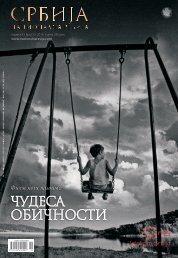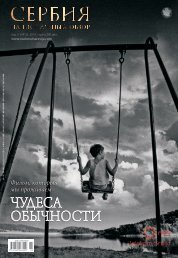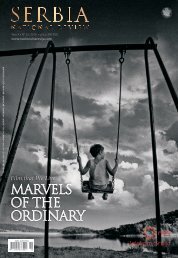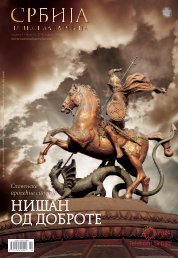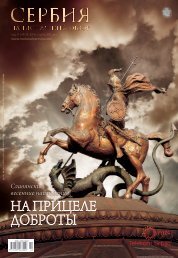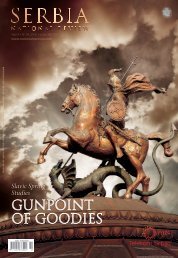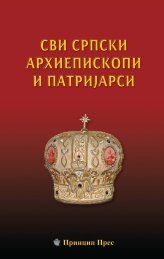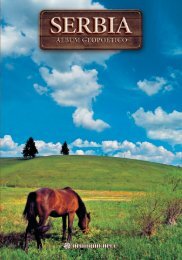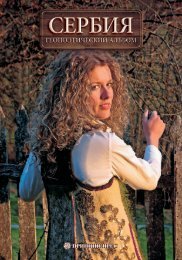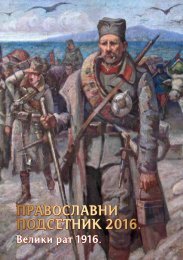Monografija - prvo izdanje - niska rezolucija
You also want an ePaper? Increase the reach of your titles
YUMPU automatically turns print PDFs into web optimized ePapers that Google loves.
262<br />
Манастир Крушедол:<br />
На падинама Фрушке горе<br />
Krušedol Monastery:<br />
On the slopes of Fruška Gora Mt<br />
Realism entered not only into all kinds of arts but also into<br />
all spheres of society itself. Hence one of the slogans launched<br />
by United Serbian Youth was “work supported by science and<br />
based on truth”. Serbian youth didn’t accept this attitude only<br />
from Western Europe but also from Russia (the best example of<br />
this are the ideas of Russian reformers that were propagated in<br />
Serbia by Svetozar Marković). The spirit of positivism spread rapidly<br />
among young students. From the beginning of the seventies<br />
Serbia became their spiritual centre.<br />
From the old “Serbian Athens” (Novi Sad) all idealist<br />
movements moved to Serbia and from 1878 (when Serbia obtained<br />
full independence) this process intensified – the most important<br />
representatives of culture and art came to Serbia, such<br />
as writers Jovan Jovanović Zmaj, Laza Kostić, Simo Matavulj,<br />
Stevan Sremac, painters Stevan Todorović, Đura Jakšić, young<br />
Đorđe Krstić and others. This process took place greatly due to<br />
the abolition of Serbian Vojvodina (dukedom) by the Austrian<br />
Emperor in 1860.<br />
From the seventh and particularly eighth decade of the<br />
19 th century the Hungarian government organized a vast action<br />
of “Hungarization” in the whole region of Vojvodina. In all<br />
public schools the Hungarian language became a compulsory<br />
subject. Personal and family names, as well as names of villages<br />
and towns received a Hungarian form. In those circumstances<br />
the space for developing the national culture and art<br />
was not only limited for many Serbs but quite often it didn’t<br />
exist at all.<br />
In the epoch of Realism the civic painting in Vojvodina<br />
kept its primary or leading role in introducing stylistic innovations.<br />
In the field of portrait art our painters demonstrated new<br />
“principles”, which this time didn’t come from the conservative<br />
Viennese Academy, but rather from the Bavarian arts capital<br />
– Münich. Thus Münich gradually took over the supremacy from<br />
Vienna in painting and artistic education of young Serbs and by<br />
the end of the 19 th century it became the actual art metropolis<br />
of Europe. It is interesting though that the first Serbian painter<br />
enrolled at Münich Fine Arts Academy (Akademie der Bildenden<br />
Künste) wasn’t a Realist but our most significant Romanticist,<br />
Đura Jakšić.<br />
However from the time of his short studies at Münich<br />
Academy (1853) until the seventies, not many Serbian painters<br />
from Vojvodina left Vienna to go to Münich. One exception was



